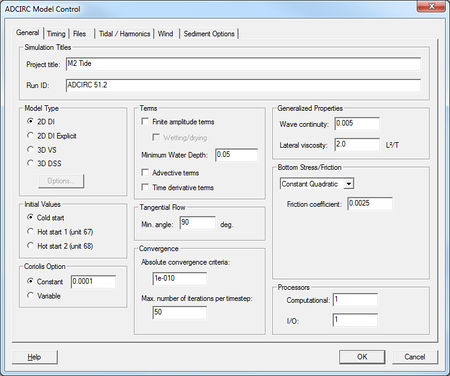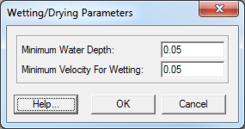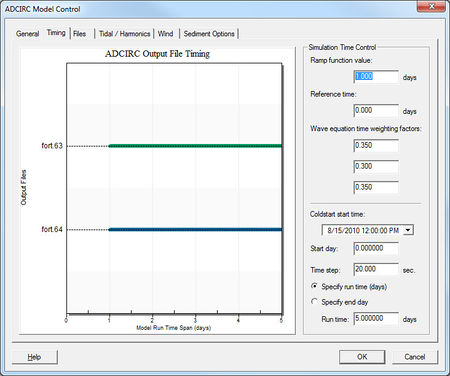User:Jcreer/SMS:ADCIRC Model Control in SMS 13.0
From XMS Wiki
Jump to navigationJump to search
The ADCIRC Model Control dialog is where important project parameters are chosen and defined. The six different tabs are listed below.
- General – Contains such options as model type, cold/hot start, terms, maximum number of iterations, bottom stress/friction, etc.
- Model Formulation
- Timing – Defines simulation run time, start time, and time step options
- Output
- Wind – Enables specific wind types and their options
- Nodal Attributes
- Harmonics Analysis – Defines tidal constituents and harmonic analysis options
- Wind – Enables specific wind types and their options
General Tab
Here is a list of items found on the General tab:
- Simulation Titles – Includes the Project Title and Run ID.
- Model Type – 2D DI, 3D VS, 3D DSS. The two dimensional depth integrated is the only option that is recommended for commercial applications at this time.
- Initial Values – Cold Start, Hot Start 1, Hot Start2. This option allows choosing a file to initialize the values of water level and velocity for a simulation. The files must have been saved from a previous run using the same finite element grid.
- Coriolis Option – Constant, Variable. The type of Coriolis forcing used does not impact run time for ADCIRC at all. Variable should be used when the coordinate system is geographic. In this case, ADCIRC will load a Coriolis coefficient for each node based on the latitude of the node. If wanting to run ADCIRC in rectilinear coordinates, specify a constant Coriolis option because the model does not support reprojection from rectilinear to geographic to determine individual latitudes for each node.
- Minimum Angle For Tangential Flow
- Terms – Finite Amplitude Terms, Advective Terms, Time Derivative Terms
- Wetting/Drying – Activating this option will cause an Options button to appear. Clicking this button will bring up the Wetting/Drying Parameters dialog.
- Solver Type – Lumped, Direct Banded, Iterative JCG – The Iterative JCG is the default and recommended solver. The other options are in the interface for backward compatibility and analytic tests.
- Absolute Convergence Criteria
- Maximum Number of Iterations per Time Step
- Generalized Properties – Wave Continuity, Lateral Viscosity
- Bottom Stress/Friction – Constant Linear, Constant Quadratic, Constant Hybrid, Varying Linear, Varying Quadratic, Friction Coefficient – The "Constant Linear" option should only be used for analytical cases when verifying the code. Linear friction causes overdamping in deep water. For "Constant Quadratic" the value of TAU0 should be set based on the principle depth. A value of TAU0 = 0.005 is suggested for deeper water (greater than 10 m depth). For shallow water, TAU0 = 0.02 is recommended. If the domain includes both shallow and deep water, consider the varying quadratic option.
Model Formulation Tab
Timing Tab
Important parameters to be aware of:
- Ramp Function Value – This value is a period of time, starting at the beginning of a simulation, that allows the full forcing of the tidal constituents to be gradually applied to the model. This prevents any issues or negative effects from occurring that could harm the results of a simulation.[1]
- Reference time – Specifies that the extracted tidal constituents are earlier or later than the start time of the simulation (see ADCIRC documentation Reftime).
- Start Day – The start time of a project
- Time Step – Time interval between successive measurements
- Run Time – Total length of time a simulation is run
- End Time – Day when simulation should finish
- ^ Militello, A., and Zundel, A. K. (1999). “Surface-water modeling system tidal constituents toolbox for ADCIRC,” Coastal Engineering Technical Note CETN IV-21, U.S. Army Engineer Research and Development Center, Vicksburg, MS.


